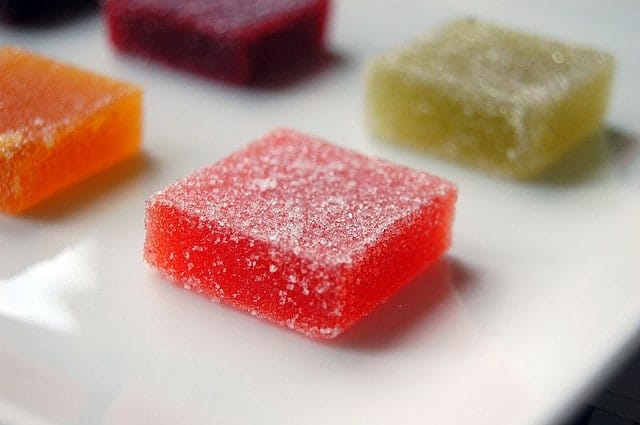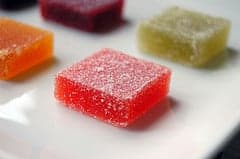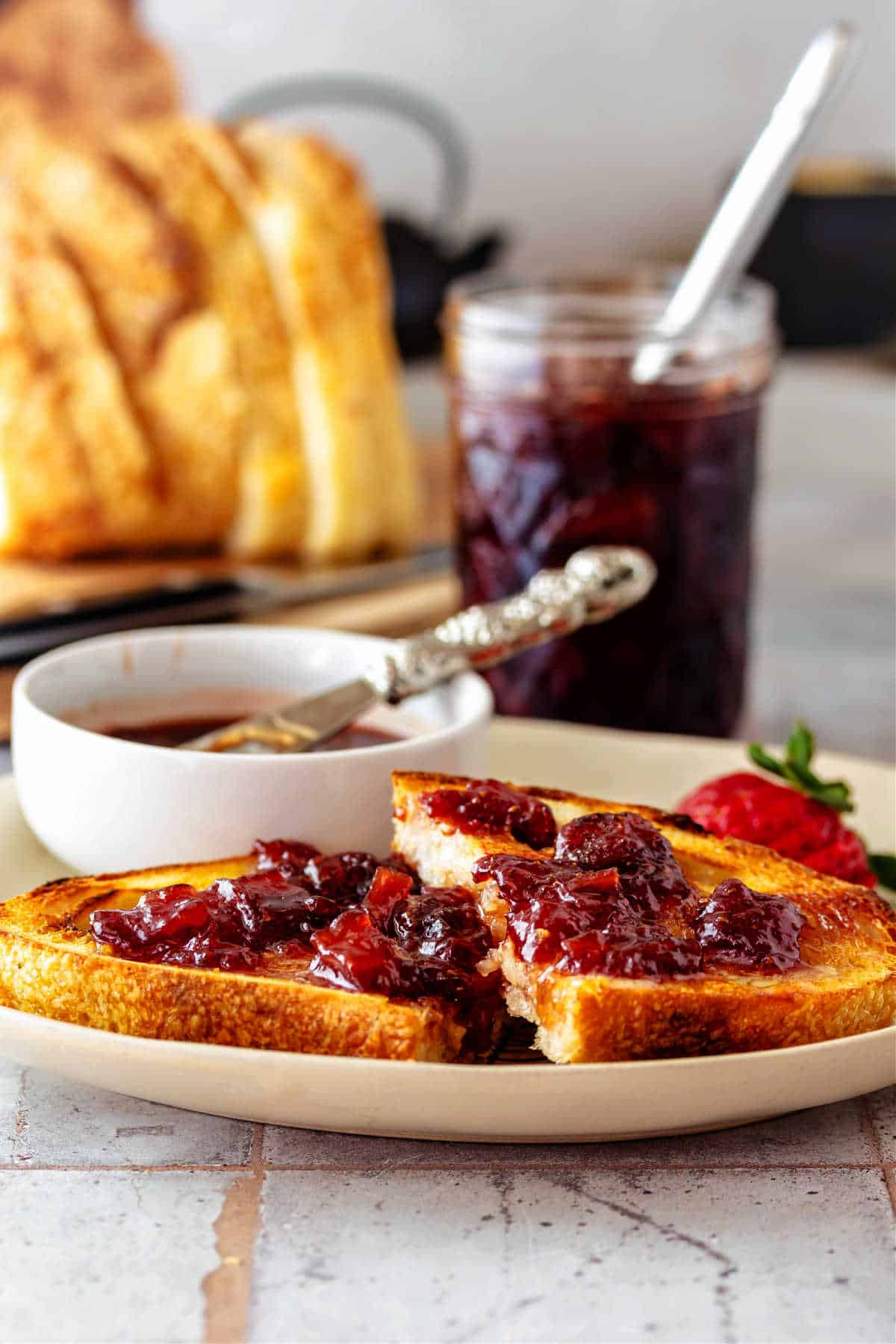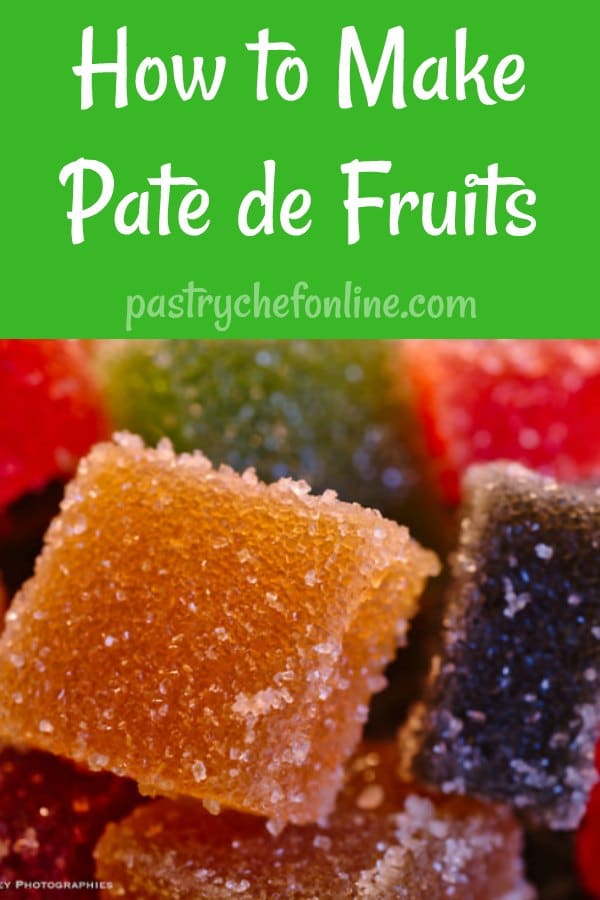You’re here to learn to make pate de fruits, right? I will teach you how to make them using raspberry as the example flavor, but first, I really want you to read this whole post (I promise it’s not too long).
In it, I’ll share some tips and tricks I learned while making these in a commercial kitchen, how to store them long term, and how to make them low-sugar.
You can also download my “cheat sheet” of 25 pate de fruit formulas optimized for Boiron purees while you’re here.
Pastry Chef Online Participates in Affiliate Programs. If you make a purchase through one of my links, I may earn a small commission. For more information click to read my disclosure policy

Pate de Fruits, At a Glance
✅Skill Level: Intermediate
✅Skills: Cooking a sugar solution to temperature
✅Type: Jelly candies
✅Number of Ingredients: 5
✅Prep Time: 15 minutes
✅Cook Time: 30 minutes or until your mixture reaches 223F
✅Yield: One half-sheet pan of pate de fruits, or about 234 1″ square candies
Jump Straight to the Recipe
The Formula

The basic pate de fruit recipe is pretty straightforward.
The trick is in knowing the perfect amount of pectin to use for each kind of fruit. Since most fruit already contains pectin at different concentrations, the amount you must add differs for most types of fruit.
Professional pastry chefs have access to formulas that are specifically formulated for each type of fruit puree a particular manufacturer sells.
I have one of these formula sheets at my disposal, and I am going to share it with you now.
NOTE: Right click on the image below and choose “Open in a new tab.”

Tips and tricks for success
While pate de fruits are not hard to make, there are some tricks to being successful with them. And I want you to be successful!
They have a short list of ingredients, but the way you mix them together can have a big impact on your finished candies. Here are some of the points to keep in mind and what I will teach you:
- The correct proportions of puree, sugar, glucose, citric acid and pectin
- How to add the pectin so your guy stay nice and smooth
- What to expect when you’re heating the puree
- How to stay safe while making them
Stick with me, and when you make perfect “fruit paste,” you’ll be rewarded with simply beautiful
- texture
- flavor
- mouthfeel
The magic of making pate de fruits is making sure you have just the right amount of thickening power, in the form of pectin, to let them set up into slick, slice-able jewel-toned tiles of fruit flavor without overdoing it and ending up with something boingy. We are not going for boingy.
Okay, we’re getting to the recipe. But first, to address some possible issues before they come up:
How Hard is it to Make Pate de Fruits?
While it’s not hard to make these little candies, it’s not really easy, either.
Or rather, it’s a fussy process.
There is a lot of stirring and cooking of thick, viscous, bubbling molten fruit and sugar.
I’ve gotten some lovely burns from exuberantly burbling pre-pate-de-fruits, so if you’re going to make some, be careful and be prepared for it to take quite a while–maybe up to 45 minutes or so of stirring.
The time isn’t as important as the temperature, and the magic temp we’re shooting for is 223F.
Can I use my own fruit puree?
Yes, you can, although if you do, I cannot guarantee that you will get perfect results with this particular formula since it is optimized for use with Boiron puree.
Having said that, I know of some folks who have used homemade puree with good results.
Just know that you may have to tweak the amount of pectin and/or citric acid to get the perfect set and balance.
Equipment
As I have said, the equipment list is not very long.
Would you like to save this post?
You’ll need a heavy bottomed saucepan, an accurate instant read thermometer, a Silpat for pouring and a half sheet pan.
I also like a pizza wheel for cutting your candies once they’ve set up, but you could also go for one of those fancy multi-wheel cutters if you know you’ll use it a lot.
I recommend storing pâte de fruits in an airtight container with a couple of desiccant packs in it to keep them nice and dry. Note that the desiccant packs I link to are rechargeable, meaning you can dry them out for repeated use.
I love this feature because you’re not just throwing them away after one use.
How Much Citric Acid?
In the formulas, the citric acid needs to be dissolved in an equal amount of water. So, if the formula calls for 15 grams of citric acid called for in the formula, dissolve 7.5 grams citric acid in 7.5 grams of water.
If the formula calls for 20 grams of citric acid, dissolve 10 grams citric acid in 10 grams of water before adding it when the formula specifies.
My favorite Boiron purees
I really recommend purchasing Boiron puree to make your pates de fruit, especially since the formulas come from Boiron and were optimized for their puree formula.
The pureee is pretty pricey, but it is fantastic. Plus, your results are all but guaranteed, as long as you follow the formulas exactly.
To begin with, I recommend just purchasing one flavor and making 1 tray of candies. If you cut them into small squares, you can easily get 400 candies, plenty for hooking up everyone on your gift list!
Start with the raspberry and then try passion fruit, strawberry, or mango. Those are some of my favorites!
These formulas also work very well with Perfect Puree and CapFruit brands.
I’d caution you about using homemade puree, since it’s not standardized. You run the risk of your pate de fruits setting up either too firmly or not firmly enough.
What kind of pectin to use
We always used powdered pectin from the “regular grocery store,” and never had any problems.
Do not purchase the low- or no-sugar needed pectin, and you should be fine. Ball and Sure-Jell are two trusted brand names that provide consistently good results.
I don’t know how to change the formula to use liquid pectin, so please stick with powdered to make your pate de fruit recipe.
Other candy recipes to try
Here are some other candy recipes you might enjoy–either for eating yourself or for gifting. Enjoy!
- Butter Mints are on the opposite end of the candy spectrum from Pate de Fruit. No cooking at all. This easy version of butter mints is really just a stiff American buttercream that you can shape into mints
- Crunchy Butterfinger Candy Bars This is another pretty exacting recipe, but the result is a crispy, crunchy, layered candy bar, much like store-bought Butterfingers. But better because you can use better chocolate!
- Bourbon Honeycomb Candy Made using Bourbon honey, this is classic “sponge” candy.
- Old-Fashioned Creamy Cocoa Fudge About as old-fashioned as you can get, this cocoa fudge was from a reader’s grandmother. All she had was the ingredient list, so I worked with it to give her the instructions. Et voila!
- Chewy Butterscotch Candy Traditional butterscotch from a very, very old recipe, I cook this only high enough so it sets into a chewy candy. If you’re interested in crunchy butterscotch, this butterscotch hard candy is right up your alley.
Questions?
If you have any questions about this post or recipe, I am happy to help.
Simply leave a comment here and I will get back to you soon. I also invite you to ask question in my Facebook group, Fearless Kitchen Fun.
If your question is more pressing, please feel free to email me. I should be back in touch ASAP, as long as I’m not asleep.
A Note About Measurements
My recipes are almost all written by weight, including liquids, unless otherwise specified.
For accuracy and consistency of results, I encourage you to buy–and use–a kitchen scale.
I promise that baking and cleanup will be so much quicker and easier.
This is the scale that I recommend for home use. I have owned and used one for years.
Don't let its small price and small size fool you. The Escali Primo is an accurate and easy-to-use food scale that I have used for years. It's easy to store, easy to use, has a tare function, and easily switches between grams and ounces/pounds for accurate measurements.
Love Pate de Fruits? Please Rate and Review the Recipe. Thanks!
It will help me and other readers so much if you take a moment to rate and leave a review for this recipe.
You can use the stars to rate 1-5 (5 is best), and leave a review in the comments. It helps me make adjustments if any are needed, and comments help others decide whether the recipe is worth making.
Other ways to share include pinning, and/or sharing on your favorite social media platform.
Thank you so much for taking the time!

NOTE: I have had good luck using these formulas with both Perfect Puree and Cap Fruit. Note that perfect puree comes in 30 oz containers, so you will need to Do Math to scale the recipe from 1000 grams of puree to 850 grams.
NOTE ABOUT CITRIC ACID: Either use lemon juice in the same amount as called for in citric acid (for example, 15 grams citric acid = 15 grams lemon juice). If using citric acid, dissolve it in an equal amount of water before adding it to your candy (for example, 15 grams citric acid = 7.5 grams citric acid dissolved in 7.5 grams of water).

Raspberry Pate de Fruits
Would you like to save this post?
Equipment
Ingredients
- 1000 grams Boiron raspberry puree (1 container)
- 1140 grams sugar
- 200 grams corn syrup
- 7.5 grams citric acid diluted in 7.5 g. water (or 15 g. lemon juice)
- 20 grams powdered pectin
Instructions
- Mix about 100 g. of sugar with the pectin. Whisk them together really well. This helps keep your pate de fruits from having pectin globs in it. So do it.
- Heat the puree to 120 degrees. F.
- Whisk and whisk, and add the pectin/sugar mixture. Bring to a boil and let boil one minute.
- Add the corn syrup and the rest of the sugar. Cook to 223 degrees, F. This could take a very long time. Your thermometer will read 218, and you'll think, "Oh, I'm almost there!" Wipe that grin off your face; this is going to take some time, so settle in and make sure you're wearing long sleeves.
- Once the mixture reaches 223F, stir in the citric acid/water mixture or the lemon juice. Cook one more minute.
- Pour the molten pate de fruits mixture into a half-sheet pan which you have lined with heavy duty plastic wrap or Silpat. Let set up at room temperature until cool and sliceable. This could take a few hours.
- Once firm, slice them into small squares, or cut out fun shapes with tiny cookie cutters. Roll them in granulated sugar. For "Sourpatch" pate de fruits, mix a little citric acid in with the sugar (to taste) and roll them in that mixture.
Did You Make Any Changes?
Notes
General Notes
Generalizable to 25 formulas in the downloadable list. To be clear, each formula requires slightly different amounts of sugar, citric acid, and pectin, so please refer to the chart. All formulas are based on 1 kg or 1000 grams of Boiron puree.Storing
Make sure to store your pate de fruits in airtight containers. For storage of more than a day or two, I recommend getting some disposable or rechargeable desiccant packs. DO NOT USE A SHARP KNIFE TO CUT THESE IF YOU POURED YOUR MIXTURE ONTO SILPAT. You will end up with 1″ squares of Silpat which are good for absolutely nothing.Clarification on Citric Acid
If the formula calls for 15 grams citric acid, you can use EITHER 7.5 grams citric acid dissolved in 7.5 grams water OR 15 grams of lemon juice. If the formula calls for 25 grams citric acid, you’ll need 12.5 citric acid dissolved in 12.5 grams water OR 25 grams lemon juice.Nutrition

Hi, y’all! I hope you’ve enjoyed this post and hopefully also learned a thing or two.
If you like my style, I invite you to sign up for my occasional newsletter, The Inbox Pastry Chef.
Expect updates on new and tasty recipes as well as a bit of behind-the-scenes action. I hope to see you there!
Thank you so much for stopping in. Take care, and have a lovely day.



Join in Today!




Hi Jennifer. Just curious before attempting, have you made this using a guitar frame? I would love to pour this into my 15×15″ guitar frame so they can be cut. If you have, do you know what thickness frame you might need? Thank you!
Hey, Peter! If you have a guitar frame, you are set! You would probably have to scale the recipe down somewhat, doing some math between the area of a half sheet and a 15 x 15 square, but yes, I think this kind of candy becomes way easier to consider making if you are set up with a guitar. I wish we’d had one at the restaurant! The ones we made were about 1/4″ or so thick if that helps with your math.
Hi Jennifer,
Is there a recipe that requires less sugar for the raspberry pate de fruits? Thank you
I’m afraid not. All my PdF formulas have a lot of sugar in them. It’s the nature of the candy. Please check out my friend’s low-sugar pdfs in the post. Hopefully that will work better for you.
Hi Jenni- feedback as requested. I made a batch using passion fruit “pulp” sold out of Restaurant Depot. It’s basically juice concentrate in appearance. The package contained 363 g so I scaled down your recipe from the Boiron handout. Had brand new pectin purchased last week from “The Head Nut” in Philly area. I cooked to 225 on the candy thermometer- there was no apparent problem with measuring the temperature of the boiling mix. I cast the mixture in a quarter sheet pan with some pastry bars (homemade) and it mostly stayed put. I let it set overnight and this morning it’s a somewhat firm gel but not pate des fruits. Do you recommend scaling up the pectin for the next batch and if so by how much? For this batch I’m considering freezing and using as a filling for chocolates. The rest may be jam for my croissants! I poured some of the mix in a silicone mold and also going to play with that. The mix is tasty, just not candy! So, to review, the variables I could play with are the amount of pectin and the cook temperature. Will value your insight.
Hey, Joe. Thanks for all that info. I wonder if maybe your puree has slightly less sugar in it than other commercial purees? I hate to have you experiment with Not Inexpensive ingredients. Consider bumping the sugar and pectin by about 10% and see what that does. You could do it variable by variable, but then you’re getting into a lot of trials, so I’d just do 10% for both in one trial unless your gut really is leaning more toward it being a pectin issue. Also make sure your thermometer is properly calibrated, just on the off chance that’s the issue. At least it’s tasty–that’s one good thing about pdfs. Even the failures make excellent ice cream sauces. 🙂
Got it; Will go with a 10% bump on both. FWIW freezing did not appreciably change the texture. Not stiff enough to dip in chocolate. Might be able to pipe it at room temp and may try that just to see. Fun with food in any case. In other news a supplier of gums and gel blends has volunteered to send me some samples (in support of a bit of research on heat-stable gels), and without asking said they would toss in some of their pectin. So I may have another variable soon. Cheers Jenni-
partial update- I used the not quite set gel to fill molded chocolates. Excellent. Will get back for a second try at PDF soon.
Hooray for repurposing the gel! Glad it worked out, Joe!
Hi Jenni- update as promised. I bumped the sugar and the pectin up by 10% and adjusted further for a bit of variance in how much fruit was in the package. The result was noticeably more set- held its shape nicely after cooling- but still not candy. Need more gelling so I’m guessing another 10% on the pectin at least. I’d prefer not making it any more sweet so rather not put any more sugar. The pectin is at 9 g now and I’m tempted to increase it by a third and take a chance on too far. Thoughts?
I would go for it, Joseph. You are obviously approaching the mark, so keep on going. I’m surprised it’s taking so much pectin, but it is what it is. I think you should be fine to increase the pectin by an additional 10% without adding more sugar. Thanks for the update–I hope you get the lovely pdf set you’re looking for with your next round!
HI!
I am making pate de fruit for a practical in my specialty/artistic techniques class. We have a time limit on the exam. I was wondering if putting the pate de fruit in the refrigerator would help expedite the setting process or if it would ruin it?
Thanks!
I would not advise refrigerating them as it could make them gummy and weepy. How much time do you have for your practical?
Hi Jenni!
I have made your recipe in the past with much success. I attempt to make another yesterday, and it didn’t set. Checking everything, I realized the pectin best used by date was 12/30/2018! So will it did setup somewhat, not enough for pate des fruit. Any way to salvage what I have or use for something else? I was using Boiron Mango, I hate to waste such lovely mango.
Thanks!
Hey, Lorne! Yeah, you don’t want to waste that–too expensive and too delicious! How firm is it? You could always serve it as jam or use it to fill a cake or maybe even donuts. Or maybe even fold together with whipped cream and serve it as a fool. Or if it’s sort of firm-ish, you could warm it and use it as ice cream sauce. Or layer it with ice cream base for a mango swirl ice cream. Or jam bars. Spread it over an oatmeal cookie-type base and then dot on more of the cookie dough and bake. Cool, slice and serve as bars. Hope some of those ideas are helpful! Take care, and be well. xo
Hello, I’ve been trying to make pate de fruit but I having problems with the pectin so I’m excited to try your recipe. The pectin in the market (sure jell fruit pectin) has other added ingredients, do I have to use more than 20g or is this accounted for in the recipe. can you share the name of the pectin you used? Thank you very much for the chart.
Hey there! I’m pretty sure we used Sure Jell, and it worked just fine for us. It has been a very long time, now, but I know we never bought any “fancy pastry chef pectin” and just relied on what we could get from the grocery store. If you’re using a standardized puree like Boiron, CapFruit, etc, it should work out fine. I’m leery of saying all will be well if starting with homemade fruit puree, because I wouldn’t know how to do the math based on the sugar content. Let me know how they turn out!
Hi Jennifer,
I have some leftover current and cherry juice I am trying to use up. Could I use that in place of the puree? Or if you have any other suggestions on ways I can use up the leftover juice, I am all ears. Thank you.
Hey, Allison. I wouldn’t advise it just because the formulas are perfected for a particular kind of puree with a known percentage of sugar. And homemade is an unknown. How much juice do you have? You can boil it down to make it syrupy–or add some sugar and then reduce it. Use it to flavor whipped cream, drizzle over cake or ice cream, use it as one of the components of a trifle. Add some to sparkling water to make a homemade cherry currant soda. I feel like it’d make a really excellent sauce for pork too. Cook the pork in a pan and then deglaze with some of your juice. Finish it off with a touch of butter and maybe some minced rosemary. Hope that helps–enjoy!
Thank you so much! It came out fantastic-I cut the passion fruit recipe in half and it was perfect for my 1/4” frame. I am topping the slab with passion fruit dark chocolate ganache for one of my bonbon flavors. My question is, once cut into pieces for dipping, can I freeze them without them breaking down or getting sticky?
Thanks!
This is a great question which I unfortunately don’t have the answer to. At the restaurant, we never tried to freeze them, and they stayed nice and fresh in their container with a desiccant pack or two for a good while. My best advice is to try it with 2-3 centers–a very small sample–just to see how they defrost, if they weep, etc. My gut feeling is that they will weep some, but it’s probably worth an experiment to see what happens. I hope your chocolate turn out well–passion fruit and chocolate is such an incredible flavor combination! Please let me know if you have the time. Thanks, Wendy!
Hi Jennifer,
Yes, worked great-no weeping. I do have a very cold freezer, which helps maybe. If you tell me how and are interested, I’ll send you a pic.
Thanks again for your help!
Oh that is great, Wendy! Thank you for the update! I’d love to see a photo/photos. You can email to [email protected] And if you don’t mind, I’d love to add them to the post with credit to you. Let me know, and again, I’m so happy they turned out well!
Thank so much for sharing your recipe and knowledge on making pdf. I just started making them. I had some failures and successes. I made a tamarind-orange and hibiscus-ginger with great results. I am planning to experiment with a variety of different flavors. The pdf’s froze really well and did not weep after defrosting them. I would like to start making them as a Christmas present. How many weeks in advance I can start making them? Thank you
Hey, Inda! You’re very welcome! Your flavors sound amazing, and you taught me something: it never even occurred to me to freeze them!
That being the case, you should be able to start them weeks before you need them. If you want to store them at room temperature, and depending on the humidity where you are, you could start a couple of weeks in advance if you have some desiccant packs and air-tight storage containers.
Good evening and thank you for this information!
I have a question: Can you use this reciped and instead of sugar coating the pate de fruit, cover (dip) it in chocolate? Thank you!
Hey Chip. That’s a really good question. I have never done it before, but I did some poking around online and I found some. It doesn’t look like they added any extra weird ingredients to the pates de fruits, and they’re enrobed in tempered chocolate, so I think you’d be fine to dip them after they cure for 24 hours or so. And to err on the side of caution, if you’re going to store them for any length of time, add a couple of desiccant packs to the container. Let me know how they turn out! Here’s the link I found for reference: https://www.burdickchocolate.com/Confections/chocolate-covered-pates-de-fruits.aspx
Hello Jennifer
In one part of the page you say to use a full sheet pan, but down in the recipe section, you call for a half sheet pan, which is it? Also, if I want to pour this directly into shapes, do you recommend spaying with oil first?
Thank you
Oops, thanks for catching that. We used to use a full sheet at the restaurant and would double it, so the recipe as written will make a half sheet. I will update the recipe to avoid confusion for anyone else.
I don’t know how a 1/2 sheet translates into individual shapes or what kind of molds you are using. If they’re flexible molds, I don’t think you will need to spray. I will say I have never made them in molds of any sort, so I don’t have experience with that. A spray could mar the finish, but since you’ll be rolling them in sugar anyway, I think it would be fine to use some nonstick spray for some insurance.
Enjoy, Morag.
Hi I read a few other people are having issues with the link, as am I. Could I get it emailed also? Thanks! Sarah
Hi, Sarah. If you right click on the image of the formula sheet, you can choose “open in a new tab,” and it should pop right up for you. This was my workaround since my optin popup wasn’t working. Still, if it’s not working for you, I’ll email you the link too. Thanks!
sound delicious, I can’t get the link to work either….thanks for sharing
Sorry! Emailing you now.
Hello there,
I am wondering when you cut and roll them in sugar if they sweat at all creating a sticky syrup sugar instead of a nice dry sugar coating.
thank you
That can happen if you have to hold them for a long period of time, and especially in humid weather. For storage longer than just a day or so, I recommend buying food safe desiccant packs and tucking a few into the container. Separate layers of cut PdFs with wax paper or parchment and use 1-2 packs per layer.
On the Boiron charts, it has apple juice as one of the ingredients. It’s quite a large amount (about 25%) to the weight of the puree. Your recipe doesn’t include that. What should I do? Thanks.
I have an old chart that doesn’t use any apple puree for any of the recipes but the apple kind. If the download isn’t working (and I really do need to look into that), I’ll email you the chart I have that doesn’t require any apple, Stephen.
Hi Jennifer. I have no idea what I’m doing wrong… I’ve followed the instructions so very carefully but my pate de fruit is coming out mushy. It sets up and keeps it shape somewhat but its not firm… Its like a very very thick jam… Also, the link for the chart isn’t working… can you send me a chart please!? Help please!! haha I have no idea what I’m doing wrong. I’ve made sure to bring it to 223. I don’t know what else I could be screwing up…
It could be that you are making candy on a humid day, which is a recipe for gooey candy. Or maybe your thermometer is off. It’s hard to know for sure. Are you making the raspberry? I’d calibrate my thermometer and then melt it down and recook it, just to save ingredient cost and to see if the thermometer is the issue. Happy to send you the page for the formulas. I’ll email it to you, William.
Thank you. I used 3 different thermometers because I thought that’s what it might be so I don’t think it’s that. Humidity is also not an issue for sure. I was doing the blood orange one. (I had a very blurry copy of the chart from an image search on google.) I’m going to attempt the white peach right now and I’ll let you know how it goes. Thank you so much!
Man, I’m hoping it’s just the blurry numbers, because it’s a pretty reliable formula, especially if your thermometer is accurate and the humidity is low. Keep me posted, and enjoy the white peach! I emailed you the page, so let me know if you have any issues with downloading, William. 🙂